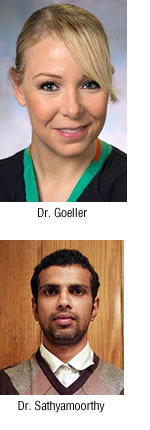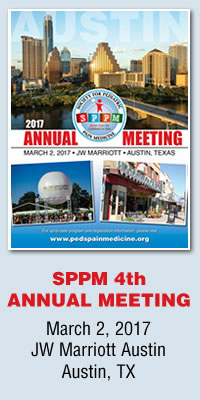Review of the Third Annual Meeting of the Society for Pediatric Pain Medicine (SPPM)
 By Jessica Goeller, DO
By Jessica Goeller, DO
Children’s Hospital and Medical Center, University of Nebraska Medical Center
Madhankumar Sathyamoorthy, MBBS, MS
Children’s Hospital of Mississippi, University of Mississippi Medical Center
The Third Annual Meeting of the Society for Pediatric Pain Medicine (SPPM) took place on March 31, 2016 at The Broadmoor Resort in Colorado Springs, Colorado. SPPM President Sabine Kost-Byerly, MD, FAAP (Johns Hopkins) and the meeting chair Yuan-Chi Lin, MD, MPH (Boston Children’s Hosptial) opened the session by welcoming the participants, reporting a growth of membership of the society from 300 to 800, and especially recognizing new attendees. Dr. Kost-Byerly also invited all members to attend committee meetings about Research, Education, Communications and planning for next years’ annual meeting. After this welcome, the SPPM meeting offered five distinct educational sessions, lunchtime PBLD sessions, moderated poster sessions and specialized afternoon workshops.
Robert T. Wilder, MD, PhD (Mayo Clinic Hospital) moderated the first session, which included lectures on neonatal pain and the biology of acute and persistent pain states, followed by a panel discussion. K. Sunny Anand, MBBS, D.Phil., FCCM (Stanford University) gave a captivating lecture on neonatal pain and the art of therapeutics in early development. He detailed the evidence that fetal and neonatal responses to noxious stimuli are painful, not reflexive, with neonates and pre-term infants being more sensitive to pain. Dr. Anand described the evolution in the evaluation and treatment of pain in the neonatal population, highlighting a multi-modal approach with pharmacological and non-pharmacological treatment modalities as optimal strategies for reduction in both pain and stress responses amongst neonates and infants. Consequently, Dr. Anand identified the need to assess and treat neonatal pain using an appropriate combination of validated pain assessment measures and tools available, as the research continues to determine the ideal doses of the many analgesic options in the developing child.
Next, Tony Yaksh, PhD (University of California, San Diego) spoke about the biology of acute and persistent inflammatory pain states. Neonatal pain pathways are still in development and myelination is still occurring amongst this patient population. Therefore, afferent pain pathways and response to noxious stimuli are modulated differently. In neonates, early input is from the more mature A fibers, while the C fibers develop later. The proximity of developing pathways can result in light touch being perceived as a noxious stimulus. Dr. Yaksh described the mechanism of central sensitization to pain after repeated peripheral noxious stimuli as increased sensitization of small afferents, collateralization and convergence of distant fibers in the dorsal horn, and an increase in the concentration of receptors at the nerve terminals. An engaging audience questions and panel discussion followed the session.
After a brief coffee break with the exhibitors, the second session, “Pediatric Regional Anesthesia”, was kicked off by Galaxy Li, MD (University of Florida). Sophie R. Pestieau, MD (Children’s National Health System, Washington DC) discussed in detail the evaluation and management of coagulopathies as they relates to pediatric regional anesthesia. She pointed out that inherited bleeding disorders are rare and routine tests fail to identify them. Laboratory testing is needed only when there is history of bleeding, history of known bleeding disorder, or clinical conditions that can be associated with coagulopathy such as sepsis or liver disease or use of medications that impair hemostasis. The American Society of Regional Anesthesia (ASRA) has published updated guidelines about the use of neuraxial and peripheral nerve blocks in the setting of impaired coagulation. But it fails to address interventional pain procedures. Even with following guidelines, specific clinical decisions need to be made on a case by case basis and high vigilance and monitoring are essential to reducing complications.
Next, Alan Bielsky, MD (Children’s Hospital Colorado) addressed the use of regional anesthesia in trauma. He pointed out that regional anesthesia is much more commonly used in trauma cases in the military but not as much in urban centers. He described many commonly performed regional blocks in trauma and highlighted the use of paravertebral blocks as an alternative to thoracic epidural for thoracic and abdominal injuries. He cited a recent practice advisory published jointly by ESRA (European Society of Regional Anesthesia) and ASRA to argue against the concern that regional anesthesia can mask the early signs of compartment syndrome.
The final presentation of the second session was given by Arjunan Ganesh, MBBS (Children’s Hospital of Philadelphia) on “Safety of Regional Anesthesia”. The published data from PRAN (Pediatric Regional Anesthesia Network) shows a very high safety profile of regional blocks in children. He cautioned that precise estimation of risk of rare events is almost impossible. He quoted the JAMA article published in 1983, “If Nothing Goes Wrong, Is Everything All Right?: Interpreting Zero Numerators” to drive home his point. But he agreed, there is enough evidence to show that pediatric regional anesthesia under general anesthesia or deep sedation is safe and can be considered as standard of care. He recommended several safe practices, including pre-operative huddle and block time-out to prevent wrong-site blocks which may be reported as sentinel events in several states. The session concluded with panel discussion and presentation of best abstract awards by Sapna Kudchadkar, MD (Chair, Research Committee) in each of the three categories of Acute Pain, Chronic Pain and Regional Anesthesia.
The third session was moderated by Benjamin H. Lee, MD, MPH (Johns Hopkins), which was an invigorating Pro/Con debate on clonidine. The Pro perspective was presented by Stephen R. Hays, MD, FAAP (Children’s Hospital at Vanderbilt). His top 10 reasons for using clonidine were: inexpensive, anti-nociceptive properties, anti-neuropathic, renal protection after contrast, opioid-sparing, safe sedation, ease of administration, recommended by experts, prevents emergence delirium, and non-neurotoxic (and may be even neuroprotective). The use of adjuvant agents, especially those that might be protective against neuro-apoptosis, is encouraged as he conveyed in his quote, “especially this cheap, very useful drug that should be widely used in pediatric practice.”
The fourth session, Integrative Medicine in Pediatric Pain, was moderated by Rosalie Tassone, MD, MPH (Sidra Medical and Research Center, Doha, Qatar). This session included discussions regarding non-pharmacological and alternative therapeutic approaches to pain. Daniel R. Hilliker, PhD, ABPP (Mayo Clinic) reviewed meditation and cognitive behavioral therapies (CBT) and its role in pediatric pain management. He explained the three main components of CBT: thought, behavior and emotion. CBT assists patients in identifying and examining triggers, thinking errors (catastrophizing), and emphasizes returning to normal activity in order to overcome anxiety and exacerbation of pain. Meditation assists in relaxation response resulting in physiological changes in the body that facilitate reduction of stress and its deleterious effects. Simultaneous psychosocial therapy with emphasis on return to normal function is a key intervention in treatment of chronic pain.
Next, Samuel Rodriguez, MD (Stanford University) discussed the role of Arts in Healing. He reviewed the history of arts and its use in healing, literature supporting art therapy for the benefit of both the patients and the physicians. Art can reduce anxiety, stress, depression, PTSD, promotes healing, improves academics, and increases empathy. For physicians, art is used as a tool to improve observation, communication, and empathy. Medical humanities can help decrease anxiety in challenging patients. He showed some excellent videos on interactive distraction techniques for pediatric anesthetic induction.
Finally, Brenda Golianu, MD (Stanford University) discussed the holistic approach to pediatric pain management. She presented data supporting successful use of acupuncture, supplements, and sleep hygiene to improve pain control. In particular, she elaborated on the efficacy of acupuncture therapy that has been shown to be effective in control of post-operative nausea and vomiting, and pain after tympanostomy or tonsillectomy. Laser acupuncture is a non-invasive method that has been shown to improve neonatal abstinence syndrome. Audience questions and panel discussion followed.
The final session, moderated by Rita Agarwal, MD, FAAP (Stanford University) was on “Enhancing Chronic Pediatric Pain Management”. Tony Yaksh, PhD, returned in the afternoon to give a brief review comparing the etiology of neuropathic pain in neonates and adults. Nerve injury causes axonal degeneration and alters protein expression in dorsal root ganglion (DRG) leading to ongoing afferent traffic from injured sensory nerve. It also lowers the threshold for mechanoceptive afferents leading to tactile allodynia. Neuropathic pain following nerve injury is rare in infants. Its incidence increases with age, with median age of 13 years.
Nancy L. Glass, MD, MBA, FAAP (Texas Children’s Hospital) gave the final talk on “Optimizing the Doctor-Patient Relationship”. In the audience poll conducted by the interactive audience response system (ARS), the majority voted that it is difficult to have a discussion about pain with teenagers (12 -18 yrs) and with children for whom there is no obvious etiology and explanation for their pain. She described a case from her experience about the difficulties of talking about pain with a 16yr old, who was recently diagnosed with disseminated osteosarcoma. The things that he would not talk about were “his fears about his dad going back to jail,” “his fears about not seeing his friend again,” and “his fears about not waking up from sleep.” She also lists the “top 10 things” that will help to win trust and respect of parents. She pointed out that parental decision making is a complex issue and even more so as it relates to the end of life decisions. The top priorities for pediatric end of life care are honest and complete information, ready access to staff, communication and care coordination, emotional support by and for staff, and preservation of integrity of the parent/child relationship and faith. She concluded by discussing difficult conversations with parents and giving some example of words that hurt and words that heal.
The day concluded with the presentation of best abstract awards by Sapna Kudchadkar, MD for the evening poster presentations.


